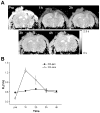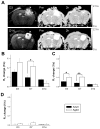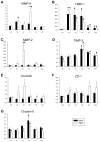Effects of aging on blood brain barrier and matrix metalloproteases following controlled cortical impact in mice
- PMID: 22201549
- PMCID: PMC4042317
- DOI: 10.1016/j.expneurol.2011.12.016
Effects of aging on blood brain barrier and matrix metalloproteases following controlled cortical impact in mice
Abstract
Aging alters the ability of the brain to respond to injury. One of the major differences between the adult and aged brain is that comparable injuries lead to greater blood brain barrier disruption in the aged brain. The goals of these studies were to quantify the effects of age on BBB permeability using high field strength MRI T1 mapping and to determine whether activation of matrix metalloproteases, their inhibitors, or expression of blood brain barrier structural proteins, occludin, zonnula occludins-1 (ZO-1) and claudin-5 were altered following injury to the aged C57/BL6 mouse brain. T1 mapping studies revealed greater blood brain barrier permeability in the aged (21-24 months old) brain than in the adult (4-6 months old) following controlled cortical impact. The increased blood brain barrier permeability in the pericontusional region was confirmed with IgG immunohistochemistry. MMP-9 activity was increased following controlled cortical impact in the aged brain, and this was accompanied by increased MMP-9 gene expression. MMP-2 activity was higher in the uninjured aged brain than in the adult brain. Occludin and ZO-1 mRNA levels were unchanged following injury in either age group, but claudin-5 mRNA levels were lower in the aged than the adult brain following injury. These results demonstrate quantitative increases in blood brain barrier permeability in the aged brain following injury that are accompanied by increased MMP-9 activation and decreased blood brain barrier repair responses.
Copyright © 2011. Published by Elsevier Inc.
Figures





Similar articles
-
Matrix metalloproteinase-2 and -9 secreted by leukemic cells increase the permeability of blood-brain barrier by disrupting tight junction proteins.PLoS One. 2011;6(8):e20599. doi: 10.1371/journal.pone.0020599. Epub 2011 Aug 17. PLoS One. 2011. PMID: 21857898 Free PMC article.
-
Increased blood-brain barrier permeability and altered tight junctions in experimental diabetes in the rat: contribution of hyperglycaemia and matrix metalloproteinases.Diabetologia. 2007 Jan;50(1):202-11. doi: 10.1007/s00125-006-0485-z. Epub 2006 Dec 2. Diabetologia. 2007. PMID: 17143608
-
The role of hypoxia-inducible factor-1α, aquaporin-4, and matrix metalloproteinase-9 in blood-brain barrier disruption and brain edema after traumatic brain injury.J Neurosurg. 2011 Jan;114(1):92-101. doi: 10.3171/2010.6.JNS10207. Epub 2010 Jul 9. J Neurosurg. 2011. PMID: 20617879
-
Specific role of tight junction proteins claudin-5, occludin, and ZO-1 of the blood-brain barrier in a focal cerebral ischemic insult.J Mol Neurosci. 2011 Jun;44(2):130-9. doi: 10.1007/s12031-011-9496-4. Epub 2011 Feb 12. J Mol Neurosci. 2011. PMID: 21318404
-
Ulinastatin protects brain against cerebral ischemia/reperfusion injury through inhibiting MMP-9 and alleviating loss of ZO-1 and occludin proteins in mice.Exp Neurol. 2018 Apr;302:68-74. doi: 10.1016/j.expneurol.2017.12.016. Epub 2017 Dec 30. Exp Neurol. 2018. PMID: 29291404
Cited by
-
Blood-brain barrier dysfunction developed during normal aging is associated with inflammation and loss of tight junctions but not with leukocyte recruitment.Immun Ageing. 2015 Mar 7;12:2. doi: 10.1186/s12979-015-0029-9. eCollection 2015. Immun Ageing. 2015. PMID: 25784952 Free PMC article.
-
Models of Traumatic Brain Injury in Aged Animals: A Clinical Perspective.Neurorehabil Neural Repair. 2019 Dec;33(12):975-988. doi: 10.1177/1545968319883879. Epub 2019 Nov 13. Neurorehabil Neural Repair. 2019. PMID: 31722616 Free PMC article. Review.
-
Gene expression and functional annotation of human choroid plexus epithelium failure in Alzheimer's disease.BMC Genomics. 2015 Nov 16;16:956. doi: 10.1186/s12864-015-2159-z. BMC Genomics. 2015. PMID: 26573292 Free PMC article.
-
The blood brain barrier: Insights from development and ageing.Tissue Barriers. 2017 Oct 2;5(4):e1373897. doi: 10.1080/21688370.2017.1373897. Epub 2017 Sep 28. Tissue Barriers. 2017. PMID: 28956691 Free PMC article. Review.
-
Harnessing BDNF Signaling to Promote Resilience in Aging.Aging Dis. 2024 Sep 3;16(4):1813-1841. doi: 10.14336/AD.2024.0961. Aging Dis. 2024. PMID: 39656488 Free PMC article. Review.
References
-
- Adams DD, Lucas WO, Williams BG, Berkeley BB, Turner KW, Schofield JC. A mouse genetic locus with death clock and life clock features. Mech Ageing Dev. 2001;122:173–89. - PubMed
-
- Berman NE, Marcario JK, Yong C, Raghavan R, Raymond LA, Joag SV, Narayan O, Cheney PD. Microglial activation and neurological symptoms in the SIV model of NeuroAIDS: association of MHC-II and MMP-9 expression with behavioral deficits and evoked potential changes. Neurobiol Dis. 1999;6:486–98. - PubMed
-
- Bilgen M. A new device for experimental modeling of central nervous system injuries. Neurorehabil Neural Repair. 2005;19:219–26. - PubMed
Publication types
MeSH terms
Substances
Grants and funding
LinkOut - more resources
Full Text Sources
Other Literature Sources
Medical
Miscellaneous

